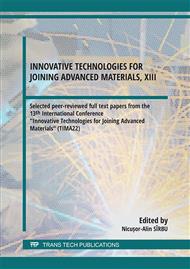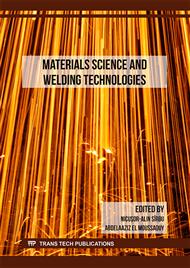p.59
p.69
p.81
p.89
p.97
p.105
p.111
p.119
p.125
The Behaviour of Hybrid Aluminium-Steel Resistance Spot Welded Joints in Case of Dynamic Loading
Abstract:
Hybrid joints between aluminium and steel are used sometimes in case of thin sheets for example for a car body. Resistance welding for this joining challenge is not frequently used, but the resistance welded joints basically have good mechanical properties. During resistance spot joining of these hybrid joints, fusion between the two materials cannot occur, but with the right technological parameters an intermetallic compound (IMC) appears in the joint line. The properties of the IMC have significant effect to the joint properties, because the researchers basically investigate this. The original static mechanical tests can show good, comparable results for the joint properties. If we see the dynamic tests basically really difficult to find results in case of spot welding of steels and joining of hybrid aluminium – steel joints. The aim of this paper to show the dynamic properties of these hybrid joints. During our investigation DP600 dual-phase steel was used as the steel part because this grade is frequently used in a car chassis. For the aluminium part, two types of aluminium were applied: non-heat treatable 5754-H22 alloy, and heat-treatable 6082-T6 alloy. The different aluminium alloys have different properties, so different technological parameter combinations were used. To test the resistance of hybrid joints against dynamic loading, instrumented impact tests were performed. This special impact test is considered as an impact-bending test, because the load is perpendicular to the welded point joint. Force – time diagrams of impact tests were shown too in this paper. The intermetallic compound is necessary for joint, but it is very brittle with very big hardness, but in case of dynamic testing this hardness has no significant effect, so these specimens show good result in case of dynamic loading. The two different aluminium – steel joints show different resistance against dynamic loading, and the fracture modes were different too.
Info:
Periodical:
Pages:
97-104
Citation:
Online since:
August 2023
Authors:
Price:
Сopyright:
© 2023 Trans Tech Publications Ltd. All Rights Reserved
Share:
Citation:



